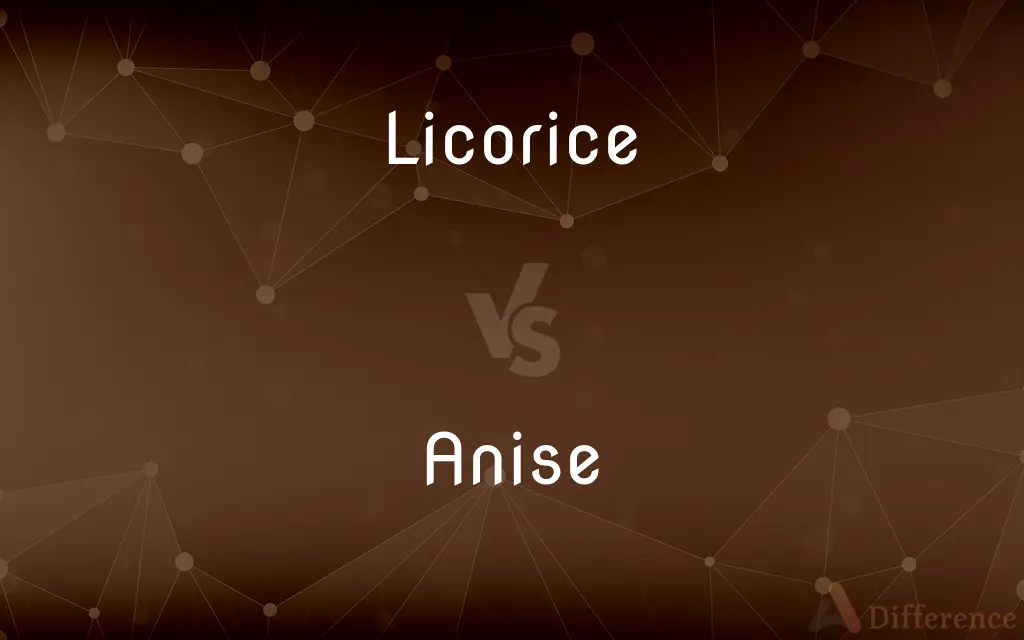Licorice vs. Anise — What's the Difference?
By Tayyaba Rehman — Updated on September 4, 2023
Licorice is a root used for flavoring and medicine, while anise is a seed with a similar taste, often used in cooking and distilling.

Difference Between Licorice and Anise
Table of Contents
ADVERTISEMENT
Key Differences
Licorice is derived from the root of the Glycyrrhiza glabra plant. This root is sweet and has been traditionally used in candies, medicines, and as a flavoring agent in various cuisines. Anise, on the other hand, comes from the seeds of the Pimpinella anisum plant and has a taste profile similar to licorice, though it is distinct and often described as being slightly more fragrant.
Both licorice and anise are renowned for their unique, sweet, and aromatic flavors, which can be quite reminiscent of each other. However, licorice tends to have a more profound medicinal background, being used in herbal remedies and even traditional medicine for its potential benefits. Anise, while also having its traditional medicinal uses, is more prominently recognized in culinary settings, especially in baked goods, liquors, and confections.
It's also worth noting the global distribution of these plants. Licorice mainly grows in parts of Europe and Asia, making it prevalent in cuisines from these regions. Anise, although also native to the Mediterranean region and Southwest Asia, has been incorporated into a variety of global dishes and is particularly notable in liquors like absinthe and ouzo.
Another distinction lies in the parts of the plants used. With licorice, it's primarily the root that's harvested for its flavor and medicinal properties. In contrast, with anise, it's the seed that's used for culinary and therapeutic purposes. Even though both have overlapping uses in flavoring foods and in traditional medicine, they remain botanically distinct entities.
Comparison Chart
Plant Part Used
Root
Seed
ADVERTISEMENT
Taste
Sweet, slightly woody
Sweet, fragrant
Main Uses
Candies, medicines, flavoring
Cooking, distilling, baking
Origin
Glycyrrhiza glabra plant
Pimpinella anisum plant
Geographical Growth
Europe and Asia
Mediterranean and Southwest Asia
Compare with Definitions
Licorice
Herbal Medicine: A plant root used for its potential medicinal properties.
Licorice has been traditionally used for digestive issues.
Anise
Culinary Seed: A seed known for its sweet, aromatic flavor.
Anise seeds add a delightful flavor to the cookies.
Licorice
Root Flavoring: The sweet root of the licorice plant used as a flavoring.
She enjoyed the strong licorice taste in her herbal tea.
Anise
Herbal Remedy: Seeds used for their potential medicinal properties.
Anise can be used as a remedy for digestive issues.
Licorice
Confectionery Ingredient: A sweet substance derived from a root used in candies.
Black licorice candy is polarizing; people either love it or hate it.
Anise
Liquor Ingredient: A primary flavoring in some alcoholic beverages.
The distinct taste of anise defines the character of absinthe.
Licorice
Color Descriptor: A shade resembling the dark color of licorice candy.
He chose a licorice black paint for his car.
Anise
A Plant: The plant from which anise seeds are derived.
The anise plant flowers in the summer with delicate white blooms.
Licorice
A Plant: The plant from which the licorice root is obtained.
The licorice plant thrives in well-drained soils.
Anise
Flavor Profile: A description of a sweet, fragrant taste.
The bread had an unmistakable anise aroma and taste.
Licorice
A Mediterranean perennial plant (Glycyrrhiza glabra) of the pea family, having blue flowers, pinnately compound leaves, and a sweet, distinctively flavored root.
Anise
Anise (; Pimpinella anisum), also called aniseed or rarely anix, is a flowering plant in the family Apiaceae native to the eastern Mediterranean region and Southwest Asia.The flavor and aroma of its seeds have similarities with some other spices, such as star anise, fennel, and liquorice. It is widely cultivated and used to flavor food, candy, and alcoholic drinks, especially around the Mediterranean.
Licorice
The root of this plant, used as a flavoring in candy, liqueurs, tobacco, and medicines.
Anise
A Mediterranean plant of the parsley family, cultivated for its aromatic seeds which are used in cooking and herbal medicine.
Licorice
Any of various similar plants.
Anise
An Asian or American tree or shrub that bears fruit with an odour similar to that of aniseed.
Licorice
A confection made from or flavored with the licorice root.
Anise
An annual, aromatic Mediterranean herb (Pimpinella anisum) in the parsley family, cultivated for its seedlike fruits and the oil obtained from them.
Licorice
A chewy confection made from sugar and corn syrup with the addition of various flavorings, often manufactured in long flexible tubes.
Anise
The seedlike fruit of this plant, used to flavor foods, liqueurs, and candies. Also called aniseed.
Licorice
(countable) The plant Glycyrrhiza glabra, or sometimes in North America, the related American Licorice plant Glycyrrhiza lepidota.
Anise
An umbelliferous plant (Pimpinella anisum) growing naturally in Egypt, and cultivated in Spain, Malta, etc., for its carminative and aromatic seeds, which are used as a spice. It has a licorice scent.
Licorice
(uncountable) A type of candy made from that plant's dried root or its extract.
Anise
"}} Fennel, Foeniculum vulgare.
Licorice
A black colour, named after the licorice.
Anise
An umbelliferous plant (Pimpinella anisum) growing naturally in Egypt, and cultivated in Spain, Malta, etc., for its carminative and aromatic seeds.
Licorice
A flavouring agent made from dried root portions of the aforementioned plant.
Anise
The fruit or seeds of this plant.
Licorice
A plant of the genus Glycyrrhiza (Glycyrrhiza glabra), the root of which abounds with a sweet juice, and is much used in demulcent compositions.
Anise
Native to Egypt but cultivated widely for its aromatic seeds and the oil from them used medicinally and as a flavoring in cookery
Licorice
The inspissated juice of licorice root, used as a confection and for medicinal purposes.
Anise
Liquorice-flavored seeds or oil used in cookies or cakes or pickles
Licorice
Deep-rooted coarse-textured plant native to the Mediterranean region having blue flowers and pinnately compound leaves; widely cultivated in Europe for its long thick sweet roots
Licorice
A black candy flavored with the dried root of the licorice plant
Common Curiosities
What is licorice?
Licorice is a root from the Glycyrrhiza glabra plant used for flavoring and medicinal purposes.
Is licorice used in candies?
Yes, licorice is a common flavoring in candies, especially black licorice.
Do licorice and anise taste the same?
They have similar sweet flavors, but anise is often described as more fragrant.
Where does anise come from?
Anise comes from the seeds of the Pimpinella anisum plant.
Can I use anise as a substitute for licorice in recipes?
In some cases, yes, due to their similar flavors, but they are distinct.
What are some beverages flavored with anise?
Absinthe and ouzo are popular liquors with an anise flavor.
Are licorice and anise plants related?
No, they are distinct botanically but have overlapping flavor profiles.
Is the licorice root naturally sweet?
Yes, it has a naturally sweet flavor.
Do licorice and anise have different origins?
Yes, licorice originates from the Glycyrrhiza glabra plant, and anise from the Pimpinella anisum plant.
Is aniseed the same as anise?
Yes, aniseed refers to the seed of the anise plant.
Where can licorice be commonly found?
Licorice is prevalent in European and Asian cuisines and medicines.
Which part of the anise plant is most commonly used?
The seed.
How is anise most commonly utilized in cooking?
In baked goods, liquors, and various dishes for its fragrant flavor.
Which is more medicinal: licorice or anise?
Both have traditional medicinal uses, but licorice is more recognized for its medicinal properties.
Which part of the licorice plant is primarily used?
The root.
Share Your Discovery

Previous Comparison
Visible vs. Viewable
Next Comparison
Permit vs. LicenseAuthor Spotlight
Written by
Tayyaba RehmanTayyaba Rehman is a distinguished writer, currently serving as a primary contributor to askdifference.com. As a researcher in semantics and etymology, Tayyaba's passion for the complexity of languages and their distinctions has found a perfect home on the platform. Tayyaba delves into the intricacies of language, distinguishing between commonly confused words and phrases, thereby providing clarity for readers worldwide.













































